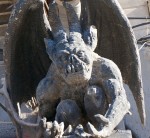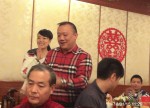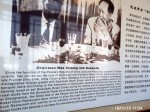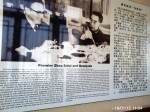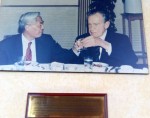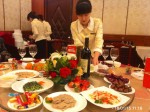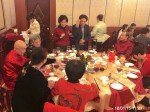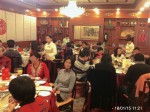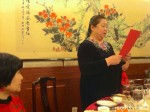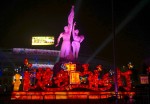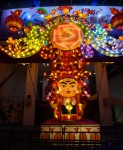I have been to quite a number of weddings and some blog entries on my other site show pictures.
A wedding is a big thing in China and normally also complicated and very expensive. Especially the bride has to change the dress several times during the banquet. Red envelopes and other presents are brought by the guests. Most of the banquets are held in hotels with intrinsicate decorations, large wedding posters, video showing the young couple, a tower of glasses to pour the champagne, etc. The crowd can be … huge.
Well, not always. This wedding of a close friend was simple but very genuine. The couple is in the first picture: the bride had a nice dress but covered it as she felt cold. No fancy decorations. No flood of presents and “hong bao”.
The location was also unusual: the famous Peking Duck Restaurant at Hepingmen, “Quanjude”. I remember that building from the eighties, it seemed a bit “far” from my Beijing Hotel. The restaurant is huge, see below. The corridors are decorated with historical pictures of famous guests. There are many floors with private rooms. The large public restaurant is usually packed and people wait patiently to get a table.
The Peking Duck is of course, delicious. I still love the dish and always eat too much.
Some history of Beijing Quanjude:
Established in 1864, with a history of 150 years, Quanjude has survived the ordeal of time. Quanjude has eight direct branches in Beijing. The original location operates in Qianmen with several other branches in other locations in Beijing.
There is a seven story restaurant on Hepingmen Ave., a location that was hand-picked by former Chinese Premier Zhou Enlai. Serving up to 5,000 meals a day, this restaurant covers a floor area of 15,000 sqm with over forty private dining rooms and can simultaneously seat 2,000 guests.
Having established a history and affiliation with the Chinese government at the municipal and central state level, Quanjude has often been used to hold state banquets and to receive celebrities, dignitaries, and important government figures from over 200 countries as distinguished VIP guests.
Per year the restaurant chain (50 affiliates across China) sells over 2 million roast ducks served in 400 different styles to over 5 million customers. Annual sales reach 500 million yuan (US$81.5 m).
With its long history, Quanjude roast duck enjoys a high reputation among domestic and overseas consumers for the peculiar roast technique and outstanding quality. It ranks the first not only in Chinese Famous Dishes, compiled by all-China famous chefs under the organization of Ministry of Commerce in 1958, but also in Elite of Chinese Famous Dishes, published by China and Japan in 1982.
In China, the well-known All-Duck Banquet is headed by Quanjude roast duck and supported by over 400 dishes with Quanjude characteristic flavor. Government leaders, officials and VIPs from nearly 200 countries and regions had dinner here.
About Quanren Yang, the establisher and the first manager of Quanjude:
Quanren Yang (1822-1890), the first manager came to Beijing from a famine-stricken area of Hebei Province. After arriving in Beijing, he was firstly engaged in buying and selling raw chicken and duck. In 1864, he rolled the dice with a grocery on the verge of bankruptcy. He renamed the firm QUANJUDE. Due to his extreme smartness and painstaking management, QUANJUDE developed from an ordinary roast duck shop front to a real restaurant characterized by roast duck done by hanging in the oven. This laid a sound foundation for the roast duck to become well known throughout Beijing.
See:
http://www.quanjude.com.au/
http://en.wikipedia.org/wiki/Quanjude







